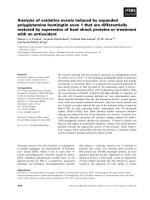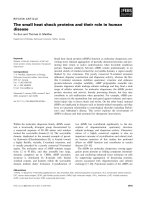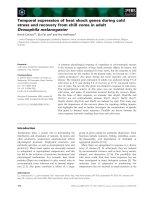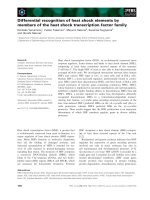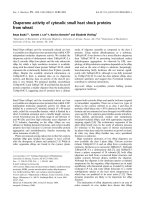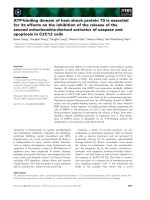Local induction of heat shock proteins using magnetic fluid hyperthermia for ocular neuroprotection in glaucoma
Bạn đang xem bản rút gọn của tài liệu. Xem và tải ngay bản đầy đủ của tài liệu tại đây (5.1 MB, 191 trang )
LOCAL INDUCTION OF HEAT SHOCK PROTEINS
USING MAGNETIC FLUID HYPERTHERMIA FOR
OCULAR-NEUROPROTECTION IN GLAUCOMA
MINHONG JEUN
NATIONAL UNIVERSITY OF SINGAPORE
2012
LOCAL INDUCTION OF HEAT SHOCK PROTEINS
USING MAGNETIC FLUID HYPERTHERMIA FOR
OCULAR-NEUROPROTECTION IN GLAUCOMA
MINHONG JEUN
A THESIS SUBMITTED FOR THE DEGREE OF
DOCTOR OF PHILOSOPHY
DEPARTMENT OF ELECTRICAL AND COMPUTER
ENGINEERING
NATIONAL UNIVERSITY OF SINGAPORE
2012
DECLARATION
I hereby declare that this thesis is my original work and it has been written by me in
its entirety.
I have duly acknowledged all the sources of information which have been used in the
thesis.
This thesis has also not been submitted for any degree in any university previously.
Minhong Jeun
22 October 2012
ACKNOWLEDGEMENTS
I
ACKNOWLEDGEMENTS
First of all, I would like to express my heartfelt gratitude to my supervisor Asst.
Prof. Bae Seongtae for his constant encouragement and kind and excellent guidance in
my researches throughout my PhD study. His constant support and valuable advice on
my study have made my PhD candidature a truly enriching experience.
I am especially grateful to Prof. Park Ki Ho, Prof. Baek Sun Ha, Prof. Kim
Young Il, Dr. Jeong Jin Wook, Dr. Park Joo Hyun, and Ms. Kim Yu Jeong of Seoul
National University Hospital for their aid in various aspects of my experimental work
and for use of their equipment. I also would like to thank Prof. Takemura and his
members of Yokohama University for help in carrying out several experimental
works.
I would like to thank my dear colleagues in Biomagnetics Laboratory (BML),
Naganivetha Thiyagarajah, Shao Quiang, Jiang Jing, Zhang Ping, Zeng Dinggui, and
Lee Shanghoon for the valuable discussion and all the fun.
I am deeply indebted to my parents for their love, unlimited support, faith, and
advice during my whole study period.
Last but not least, I heartily thank Misun Kwon who has been there for me
through all the good times and the bad times. Her continuous faith and heartfelt
support were great encouragement to me.
TABLE OF CONTENTS
II
TABLE OF CONTENTS
ACKNOWLEDGEMENT
I
TABLE OF CONTENTS
II
SUMMARY
VI
LIST OF TABLES
IX
LIST OF FIGURES
X
PUBLICATIONS AND CONFERENCES
XVI
LIST OF ABBREVIATIONS AND SYMBOLS
XXI
CHAPTER 1 INTRODUCTION
1
1.1 Background and Motivation
1
1.2 Research Objectives
5
1.3 Organization of Thesis
7
Chapter 1 References
9
CHAPTER 2 LITERATURE REVIEW
12
2.1 Glaucoma – Causes, Symptoms, and Current Therapy Methods
12
2.2 Ocular Neuroprotection in Glaucoma
16
2.3 Heat Shock Proteins (HSPs)
17
2.3.1 Ocular Neuroprotective Effect of HSPs 70 families
17
2.3.2 Current Methods for Induction of HSPs and Limitations
18
2.4 Hyperthermia
20
2.5 Magnetic Fluid Hyperthermia (MFH)
23
2.5.1 Introduction
23
2.5.2 Ferrofluids with SPNPs for MFH
25
2.6 AC Magnetically-Induced Heat Generation of SPNPs
29
2.6.1 Choices of magnetic materials
29
2.6.2 Superparamagnetism
31
2.6.3 AC heat generation mechanisms
33
2.6.4 Specific loss power
36
Chapter 2 References
39
TABLE OF CONTENTS
III
CHAPTER 3 EXPERIMENTAL TECHNIQUES
45
3.1 Synthesis of SPNPs – High Temperature Thermal Decomposition
Method
45
3.1.1 Introduction
45
3.1.2 Preparation of SPNPs
46
3.2 Coating of SPNPs with Amorphous Silica and Polyethylene
Glycol for Ferrofluids
49
3.3 SPNPs MFH Agents Characterization Techniques
51
3.3.1 Transmission of Electron Microscope (TEM)
51
3.3.2 Vibrating Sample Magnetometer (VSM)
52
3.3.3 X-ray diffraction (XRD)
53
3.3.4 Physical Property Measurement System (PPMS)
55
3.3.5 Magnetic Property Measurement System (MPMS)
56
3.3.6 Measurement of AC Magnetically-Induced Heat
Temperature
56
3.3.7 Dynamic Light Scattering System (DLS)
57
3.4 Cell Viability and Cellular Uptake of Nanoparticles
59
3.4.1 Cell Counting Kit-8 Assay
59
3.4.2 TEM Study and Cellular Uptake
59
3.5 Identification of Induction of Heat Shock Proteins 72 - Cell
Staining (Fluorescein Isothiocyanate and 4’, 6-Diamino-2-
Phenylindole) and Western Blot Analysis
60
3.6 Infusion of SPNPs to Retina in Animal Model
61
Chapter 3 References
63
CHAPTER 4 PHYSICAL LIMITS OF CURRENT
SUPERPARAMAGNETIC Fe
3
O
4
NANOPARTICLES FOR MFH
AGENT APPLICATIONS
64
4.1 Introduction and Motivation
64
4.2 Particle Size and Particle Distribution
67
4.3 Dependence of Magnetic Phase on Particle Size
69
4.4 Dependence of AC Magnetically-Induced Heating Characteristics
on Magnetic Phase and Mechanisms
72
TABLE OF CONTENTS
IV
4.5 Summary
77
Chapter 4 References
78
CHAPTER 5 PHYSICAL STUDIES FOR IMPROVING AC
MAGNETICALLY-INDUCED HEATING OF SPNPS FOR MFH
AGENT APPLICATIONS
79
5.1 Introduction and Motivation
79
5.2 Physical Mechanism and Crucial Physical Parameters to Enhance
AC Heat Generation Power of SPNPs
81
5.2.1 Size, size distribution, and T
AC,mag
of SPNPs
83
5.2.2 Physical mechanism and crucial physical parameters
83
5.2.3 Biocompatibility of SPNPs
91
5.2.4 Summary
92
5.3 Physical Contribution of Néel and Brown Relaxation loss Power
to AC Heat Generation of MFH Agents
93
5.3.1 Size, size distribution, and magnetic property of
nanoparticles
94
5.3.2 Coating and dispersion statuses of silica coated SPNPs
in fluids
5.3.3 Biocompatibility of ferrofluids
96
97
5.3.4 Dependence of Néel and Brown relaxation loss power of
ferrofluids on viscosity
5.3.5 Summary
98
103
Chapter 5 References
104
CHAPTER 6 Mn
x
Zn
1-x
Fe
2
O
4
SPNPs FOR MFH AGENT
APPLICATIONS
107
6.1 Introduction
107
6.2 Crystal Structure and Particle Size
110
6.3 Effects of Relative Concentration of Mn
2+
and Zn
2+
on Magnetic
and AC Heating Characteristics
112
6.3.1 Effects of Mn
2+
and Zn
2+
concentration on saturation
magnetization
112
6.3.2 Effects of Mn
2+
and Zn
2+
concentration on AC
TABLE OF CONTENTS
V
magnetically-induced heating characteristics and AC magnetic
properties
114
6.4 Cell Viability of Solid State Mn
x
Zn
1-x
Fe
2
O
4
SPNPs
119
6.5 Summary
121
Chapter 6 References
122
CHAPTER 7 LOCAL INDUCTION OF HSPS 72 USING MFH WITH
ENGINEERED Mn
0.5
Zn
0.5
Fe
2
O
4
(EMZF) SPNPs
123
7.1 Introduction
123
7.2 Magnetic Properties and AC Heating Characteristics
126
7.2.1 Magnetic and AC heating properties of solid state
EMZF SPNPs
126
7.2.2 Coating status and AC heating characteristics of coated
EMZF SPNPs dispersed in fluids
130
7.3 Biocompatibility – Cytotoxicity and Cellular Uptake
136
7.4 Local Induction of HSPs 72 in RGCs by MFH
141
7.4.1 Optimization of concentration of EMZF@PEG SPNPs
and holding time of AC heating stress for induction of HSPs 72
141
7.4.2 Induction of HSPs 72 by MFH with EMZF@PEG and
Fe
3
O
4
@PEG SPNPs
145
7.4.3 Improvement of induction efficiency of HSPs 72 –
control of increasing rate of AC heating stress
148
7.4.4 Improvement of induction efficiency of HSPs 72 –
control of duty cycle of AC heating stress
151
7.5 A new infusion technique to introduce SPNP agents to the retina
layer
156
7.6 Summary
159
Chapter 7 References
160
CHAPTER 8 CONCLUSIONS AND FUTURE WORK
162
8.1 Conclusions
162
8.2 Suggestions for Future Work
166
SUMMARY
VI
SUMMARY
In recent years, the research interests in glaucoma therapy have been shifted
toward “ocular neuroprotection” because dropping the intraocular pressure has been
shown to be unable to prevent progressive vision loss in glaucoma. Among several
ocular neuroprotective approaches, induction of heat shock proteins (HSPs),
particularly HSPs 72, in retinal ganglion cells (RGCs) has been paid considerable
attention as an efficacious approach for ocular neuroprotection. However, the current
biotechnical approaches to induced HSPs have critical limits to use in clinics due to
undesirable systemic or chemical side effects and correspondingly low local induction
efficiency of HSPs.
In this thesis, magnetic fluid hyperthermia (MFH) using a fluidic
superparamagnetic nanoparticles (SPNPs) agent has been designed and explored as a
potential modality to achieve the high efficient local induction of HSPs in RGCs and
to minimize the cell death rate (side effects) by controlling AC heating stress in RGCs
during HSPs induction process.
Firstly, magnetic and AC magnetically-induced heating properties of Fe
3
O
4
nanoparticles, widely studied as a hyperthermia agent, were investigated and it was
demonstrated that pure superparamagnetic phase Fe
3
O
4
nanoparticles showed
insufficient specific loss power (SLP) critically limiting for MFH applications.
Accordingly, in order to develop a new powerful SPNP agent, we empirically and
physically investigated the physical mechanisms of AC magnetically-induced heating
and identified what physical parameters would be the most critical to enhance the AC
magnetically-induced heating characteristics of SPNPs using various kinds of solid
state SPNPs (Fe
3
O
4
, NiFe
2
O
4
, MgFe
2
O
4
, and Mn
x
Zn
1-x
Fe
2
O
4
).
SUMMARY
VII
Secondly, the AC magnetically-induced heating characteristics of various viscous
(1 × 10
-3
Pa·s ~ 4 × 10
-3
Pa·s) ferrofluids with either soft-ferrite or hard-ferrite SPNPs
were investigated and analyzed to empirically interpret the contribution of Néel
relaxation loss (soft-ferrite) or Brown relaxation loss (hard-ferrite) to the total AC heat
generation of superparamagnetic MFH agents. The contribution of Brown relaxation
loss was severely affected by the viscosity, while the contribution of Néel relaxation
loss was independent of the variation of viscosity.
Thirdly, the Mn
x
Zn
1-x
Fe
2
O
4
SPNPs were intensively explored as a potential
candidate for a MFH agent. The effects of relative concentrations of Mn
2+
cations and
Zn
2+
cations on the AC magnetically-induced heating characteristics, magnetic
properties, and biocompatibilities of Mn
x
Zn
1-x
Fe
2
O
4
SPNPs were systematically
investigated and it was found that the Mn
0.5
Zn
0.5
Fe
2
O
4
SPNP showed the highest AC
magnetically-induced heating temperature (T
AC,mag
), specific loss power (SLP), as
well as biocompatibility.
Fourthly, the Mn
2+
cation concentration and its distribution in tetrahedral (A) and
octahedral (B)-sites of the Mn
0.5
Zn
0.5
Fe
2
O
4
SPNP were thermally controlled during a
process of synthesizing nanoparticles to improve the magnetic properties and the AC
magnetically-induced heating characteristics (engineered Mn
0.5
Zn
0.5
Fe
2
O
4
SPNP,
EMZF SPNP) for successful control of the AC heating stress in RGCs. In addition,
applicability of EMZF SPNP to a MFH agent for local induction of HSPs 72 was
demonstrated.
Finally, the AC heating stress (or AC heating) controllable MFH was
demonstrated to be promising for high efficient local induction of HSPs 72 in RGCs.
The AC heating stress (AC heating) in RGCs was successfully controlled by tuning
the applied AC magnetic field in the biologically tolerable and physiologically safe
SUMMARY
VIII
rage (H
appl
·f
appl
< 1.78 x 10
9
Am
-1
s
-1
). It was found that the induction efficiency of
HSPs 72 and cell survival rate were significantly improved by controlling the AC
heating stress in RGCs.
LIST OF TABLES
IX
LIST OF TABLES
Table 2-1
Various forces acting in a ferrofluids
28
Table 4-1
Mean hydrodynamic diameters (d
H
), size distributions, and
polydispersity index (PDI) values of DMSA coated Fe
3
O
4
nanoparticles
67
Table 4-2
SLPs of DMSA coated Fe
3
O
4
nanoparticles with different
particle sizes
72
Table 4-3
Summaries of calculated and measured physical values
(parameters) of Fe
3
O
4
nanoparticles with different: AC/DC
hysteresis area (loss), out-of-phase magnetic susceptibility,
P
total
, P
Néel
, and the contribution of P
Néel
to the P
total
in percent
76
Table 5-1
Calculation results of the real contributions of P
Neel relaxation loss
to the P
total
and the magnetic anisotropy value of each
superparamagnetic nanoparticle
89
Table 7-1
The effective concentration of EMZF@PEG SPNPs uptake in
the RGCs quantitatively analyzed using an ICP-MS. The
RGCs were treated and incubated by EMZF@PEG ferrofluids
with different concentrations of 300, 500, and 700 µg/mL
139
LIST OF FIGURES
X
LIST OF FIGURES
Figure 2-1
Progressive loss of vision caused by glaucoma
12
Figure 2-2
Damage of optic nerve or RGCs caused by increased IOP
(left) and open angle glaucoma and closed angle glaucoma
(right, red arrows: aqueous humor)
13
Figure 2-3
Created new channel for more normal flow of aqueous
humor by trabeculectomy
14
Figure 2-4
The SOLX deep light glaucoma treatment system combines
a titanium sapphire laser with a gold shunt (shown at far left
next to a quarter and at right inserted into an eye). At lower
left and right are photos of a patient’s trabecular meshwork
before and after treatment
15
Figure 2-5
Schematic diagram of induction of HSPs
17
Figure 2-6
Schematic diagram of whole body hyperthermia to induce
HSPs (left) and fundus photographs after laser irradiation
with different powers (right): at high powers (> 120 mW),
peripapillary whitening was observed in all treated eyes
18
Figure 2-7
An example of equipment of superficial and interstitial
hyperthermia
20
Figure 2-8
(a) Superficial microwave hyperthermia of malignant
melanoma of the skin, (b) interstitial hyperthermia in a
radical treatment of right breast cancer
21
Figure 2-9
An example of (a) thermal chamber and (b) hot water
blanket for whole-body hyperthermia
22
Figure 2-10
Experimental set-up for AC heat measurements of ferrofluids
23
Figure 2-11
Formation of colloidal suspension
25
Figure 2-12
Schematic diagram of the property of SPNPs fluid
27
Figure 2-13
Kinds of magnetism
30
Figure 2-14
Hysteresis loops of (left) single-domain (smaller particle)
and multi-domain (larger particle) and (right)
superparamagnetic depending on the size of particle
31
Figure 2-15
Effect of particle size on the magnetic coercivity
32
Figure 2-16
Illustration of the two components of the magnetic relaxation
of nanoparticles
33
Figure 2-17
Relaxation time vs particle size for magnetite particles
35
Figure 2-18
Relaxation times of magnetic moment orientational
dynamics as a function of particle diameter and viscosity
35
Figure 2-19
Temperature rise rate in polydisperse ferrofluid with Fe
3
O
4
nanoparticles
37
Figure 3-1
Illustration of HTTD method for synthesis of SPNPs
46
Figure 3-2
Procedure of HTTD method to synthesize SPNPs
48
Figure 3-3
TEM images of silica and PEG coated Mn
x
Zn
1-x
Fe
2
O
4
SPNPs (coating thickness: ~ 2 mn) and ferrofluids with PEG,
DMSA, and silica coated SPNPs
50
LIST OF FIGURES
XI
Figure 3-4
Schematic diagram of structure of TEM
51
Figure 3-5
LS 7407 VSM system
52
Figure 3-6
Bragg diffraction. Two incident waves with identical
wavelength and phase approach a crystalline solid ant are
scattered off two different atoms within it. The lower beam
traverses an extra length of 2dsinƟ. Constructive
interference occurs when this length is equal to an integer
multiple of the wavelength of the radiation
54
Figure 3-7
XRD patterns for all the nanoparticles used in this thesis
54
Figure 3-8
Physical property measurement system, Quantum Design
55
Figure 3-9
AC magnetic field generation system
57
Figure 3-10
Structure of DLS, Zetasizer Nano ZS
58
Figure 4-1
TEM images of Fe
3
O
4
nanoparticles with different mean
diameters. (a) 4.2 nm, (b) 5.8 nm, (c) 9.8 nm, (d) 11.8 nm,
(e) 16.5 nm, and (f) 22.5 nm
68
Figure 4-2
(a) Dependence of saturation magnetization and coercivity
on the particle size of Fe
3
O
4
nanoparticles, and (b) ZFC/FC
curves of Fe
3
O
4
nanoparticles (d = 4.2, 9.8, 11.8, 16.5, and
22.5 nm)
70
Figure 4-3
AC magnetically-induced heating characteristics of Fe
3
O
4
nanoparticles with different particle sizes measured at H
appl
of 140 Oe and f
appl
of 110 kHz: (a) solid state Fe
3
O
4
nanoparticles and (b) DMSA coated Fe
3
O
4
nanoparticles
dispersed in an agar solution
73
Figure 4-4
Minor hysteresis loops of Fe
3
O
4
nanoparticles: (a) DC minor
hysteresis loops swept at H
appl
of ±140 Oe, and (b) AC
minor hysteresis loops swept at the fixed f
appl
of 110 kHz
with the H
appl
of ±140 Oe
75
Figure 5-1
The particle size and the size distributions of the
superparamagnetic MgFe
2
O
4
, NiFe
2
O
4
and Mn
0.5
Zn
0.5
Fe
2
O
4
nanoparticles measured by HR-TEM
82
Figure 5-2
DC minor hysteresis loop of superparamagnetic
nanoparticles measured at a DC H
appl
of ±140 Oe
84
Figure 5-3
AC magnetically-induced heating temperatures of solid state
superparamagnetic nanoparticles measured at the fixed H
appl
of 140 Oe and f
appl
of 110 kHz
84
Figure 5-4
Intrinsic magnetic properties of all the three
superparamagnetic nanoparticles: (a) AC hysteresis loop, (b)
AC hysteresis loop measured at the sweeping field of ± 25
Oe with f
appl
: 110 kHz, (c) in-phase magnetic susceptibility,
and (d) out-of-phase magnetic susceptibility
88
Figure 5-5
Studies of in-vitro biocompatibility of the superparamagnetic
nanoparticles: (a) cell survival rate of all the
superparamagnetic nanoparticles with neuronal stem cells,
and (b) TEM study results of cellular uptake characteristics
of all the superparamagnetic nanoparticles by human neural
cells
91
Figure 5-6
The mean particle size and size distribution of synthesized
LIST OF FIGURES
XII
solid state (a) CoFe
2
O
4
and (b) Fe
3
O
4
nanoparticles analyzed
by HR-TEM
94
Figure 5-7
The DC minor hysteresis loop of (a) CoFe
2
O
4
and (b) Fe
3
O
4
nanoparticles measured at the sweeping field, H
appl
of ±140
Oe
95
Figure 5-8
The hydrodynamic diameter (d
H
), the Z-potential, and the
poly dispersity index (PDI) of silica coated (a) CoFe
2
O
4
and
(b) Fe
3
O
4
SPNPs dispersed in fluids
96
Figure 5-9
TEM study results of retinal ganglion cells (RGCs) before
and after treating by ferrofluids: (a) control RGCs, (b) RGCs
treated by silica coated CoFe
2
O
4
SPNPs ferrofluid, and (c)
RGCs treated by silica coated Fe
3
O
4
SPNPs ferrofluid
97
Figure 5-10
(a) The inductance-capacitance (L-C) controlled AC
magnetically-induced heating system used for measuring AC
heating of Co- and Fe-ferrofluids with different viscosities.
Figure (b), and (c) show the dependence of surrounding
viscosity of Co-ferrofluid, and Fe-ferrofluid on the AC
magnetically-induced heating temperature rise
characteristics. The viscosity of two ferrofluids was varied
from 1 × 10
-3
to 4 × 10
-3
Pa·s
100
Figure 5-11
The dependence of viscosity on the (a) specific loss power,
and (b) total AC heating power in AC magnetically-induced
heating characteristics of Co- and Fe-ferrofluids
102
Figure 6-1
TEM images and XRD patterns of synthesized
superparamagnetic Mn
x
Zn
1-x
Fe
2
O
4
nanoparticles with
different Mn composition: (a) x = 0.33, (b) x = 0.5, (c) x =
0.67 and (d) XRD patterns
110
Figure 6-2
5-2 Minor magnetic hysteresis loops of Mn
x
Zn
1-x
Fe
2
O
4
SPNPs with different Mn-Zn concentration changed from x
= 0.2 to x = 0.8
112
Figure 6-3
(a) Major magnetic hysteresis loops and (b) Ms values of
Mn
x
Zn
1-x
Fe
2
O
4
SPNPs with different Mn-Zn concentration
changed from x = 0.2 to x = 0.8, and (c) Magnetic spin
alignment diagram (yellow arrow: magnetic moment)
113
Figure 6-4
(a) Dependence of Mn
2+
concentration on the AC
magnetically-induced heating temperature measured at the
fixed H
appl
= 80 Oe and f
appl
= 210 kHz, and Dependence of
applied (b) magnetic field and (c) frequency on the AC
magnetically-induced heating temperature of Mn
x
Zn
1-x
Fe
2
O
4
SPNPs
114
Figure 6-5
Measured (a) out-of-phase magnetic susceptibilities and (b)
AC magnetic hysteresis loops of Mn
x
Zn
1-x
Fe
2
O
4
SPNPs
115
Figure 6-6
Néel relaxation loss power, total heat generation power, and
SLP (measured in solid state) of Mn
x
Zn
1-x
Fe
2
O
4
SPNPs
117
Figure 6-7
Cell viability of (a) Mn
x
Zn
1-x
Fe
2
O
4
SPNPs (x = 0.33, 0.5,
and 0.67) with neuronal stem cells isolated from human fetal
midbrain, and (b) Mn
0.5
Zn
0.5
Fe
2
O
4
and Fe
3
O
4
SPNPs with
retinal ganglion cells
119
LIST OF FIGURES
XIII
Figure 7-1
The specially designed AC magnetically-induced heating
system used for measuring the AC heating of SPNPs in
RGCs
125
Figure 7-2
TEM images of uncoated engineered Mn
0.5
Zn
0.5
Fe
2
O
4
nanoparticles
126
Figure 7-3
(a) Measured ZFC/FC of EMZF-SPNPs at the applied field
of 100 Oe, and (b) minor hysteresis loops of uncoated
EMZF, conventional Mn
0.5
Zn
0.5
Fe
2
O
4
, and Fe
3
O
4
SPNPs
measured at the applied field of ± 140 Oe
127
Figure 7-4
AC magnetically-induced heating temperature of the SPNPs
measured in solid state
128
Figure 7-5
Intrinsic magnetic properties of EMZF, Mn
0.5
Zn
0.5
Fe
2
O
4
, and
Fe
3
O
4
SPNPs: (a) AC hysteresis loop and (b) out-of-phase
magnetic susceptibility
129
Figure 7-6
(a) HR-TEM image of EMZF@PEG SPNPs dispersed in
water (the EMZF SPNP successfully coated with a very thin
PEG layer around 2 nm thickness and they were well
dispersed in water with minimal aggregation) and (b) FTIR
spectra of EMZF@PEG SPNPs disperse in water
131
Figure 7-7
DLS data including hydrodynamic diameter (d
H
), poly
dispersity Index (PDI) and Z-potential for three nanofluids:
(a) EMZF@PEG nanofluid, (b) conventional
Mn
0.5
Zn
0.5
Fe
2
O
4
@PEG nanofluid, and (c) Fe
3
O
4
@PEG
nanofluid
132
Figure 7-8
AC magnetically-induced heating temperature rise
characteristics of three coated SPNPs dispersed in water
measured at the fixed AC magnetic field of f
appl
= 140 kHz
and H
appl
= 140 Oe with varied concentration of 1 mg/mL ~ 5
mg/mL. (a) EMZF@PEG ferrofluid, (b) conventional
Mn
0.5
Zn
0.5
Fe
2
O
4
@PEG ferrofluid, and (c) Fe
3
O
4
@PEG
ferrofluid
133
Figure 7-9
The specific loss power (SLP) of all the ferrofluids
calculated based on the AC heating characteristics obtained
in Fig. 7-8
134
Figure 7-10
Studies of in-vitro biocompatibility of uncoated Fe
3
O
4
and
EMZF SPNPs and silica coated EMZF SPNPs with RGCs:
(a) Cell survival rate of uncoated EMZF and Fe
3
O
4
and silica
coated (thickness: 2 nm ~ 7 nm) EMZF SPNPs with different
nanoparticle concentrations, and (b) TEM study results of
RGCs containing uncoated and silica coated (2 nm)
EMZFSPNPs
137
Figure 7-11
Studies of in-vitro biocompatibility of EMZF@PEG and
Fe
3
O
4
@PEG SPNPs with RGCs: (a) Cell survival rate of
EMZF@PEG and Fe
3
O
4
@PEG SPNPs with different
concentrations, and (b) TEM study results of RGCs treated
by EMZF@PEG SPNPs
138
Figure 7-12
AC magnetically-induced heating temperature rise
characteristics of RGCs treated by EMZF@PEG SPNPs
LIST OF FIGURES
XIV
measured at the fixed applied frequency of 140 kHz and
magnetic field of 140 Oe with the concentrations varied from
300 ug/mL to 700 ug/Ml
141
Figure 7-13
The stained results of HSPs 72 induction (left), nucleus
(middle), and HSPs 72 + nucleus (right) in the RGCs after
MFH using EMZF@PEG SPNPs with the concentration
varied from 300 μg/mL to 700 μg/mL
142
Figure 7-14
AC magnetically-induced heating temperatures of RGCs
treated by the EMZF@PEG SPNPs (500 μ g/mL) with
different holding time of AC heating from 600 sec to 1200 sec
measured at the fixed applied frequency of 140 kHz and
magnetic field of 140 Oe
143
Figure 7-15
The stained results of HSPs 72 induction (left), nucleus
(middle), and HSPs 72 + nucleus (right) in the RGCs after
MFH using EMZF@PEG SPNPs controlled the holding time
of AC heating: (a) 600 sec, (b) 900 sec, and (c) 1200 sec
144
Figure 7-16
Western blot finding of HSPs 72 and β -actin (loading
control). (a) RGCs only, (b) RGCs + AC magnetic field (f
appl
= 140 kHz, H
appl
= 140 Oe for 900 sec) + no EMZF@PEG
SPNPs, (c) RGCs + EMZF@PEG SPNPs (500 μg/mL) + no
AC magnetic field, and (d) RGCs + EMZF@PEG SPNPs
(500 μg/mL) + AC magnetic field (f
appl
= 140 kHz, H
appl
=
140 Oe for 900 sec ). The protein levels of HSPs 72 were
assessed by Western blotting, which identified the induction
of HSPs 72 definitely in (d) than other controls groups (a, b,
and c)
146
Figure 7-17
(a) AC magnetically-induced heating temperature rise
behaviors of RGCs pellets treated by 500 µg/mL of
EMZF@PEG and Fe
3
O
4
@PEG SPNPs measured at the fixed
AC magnetic field of f
appl
= 140 kHz and H
appl
= 140 Oe, and
(b) the stained results of HSPs 72 induction in the RGCs after
MFH for 900 sec (left: HSPs 72, right: HSPs 72 + nucleus)
147
Figure 7-18
Dependence of increasing rate of AC heating stress or AC
heating-up rate, (ΔT/Δt) to a constant HSPs temperature of
40.5 ℃ ± 0.5 ℃ on the local induction rate of HSPs 72 and
the cell survival rate (or cell death rate) in RGCs treated by
500 µg/mL of EMZF@PEG ferrofluidic solution.: (a) control
group, RGCs with EMZF@PEG SPNPs but no applied AC
magnetic field, (b) ΔT/Δt = 0.118 ℃/s, f
appl
= 140 kHz, H
appl
=
160 Oe, (c) ΔT/Δt = 0.091 ℃/s, f
appl
= 140 kHz, H
appl
= 140
Oe, (d) ΔT/Δt = 0.062 ℃/s, f
appl
= 140 kHz, H
appl
= 130 Oe,
and (e) ΔT/Δt = 0.038 ℃/s, f
appl
= 140 kHz, H
appl
= 120 Oe
149
Figure 7-19
A schematic diagram to illustrate a duty cycle of the AC
heating stress
151
Figure 7-20
Duty cycle controlled AC heating temperatures (AC heating)
of RGCs treated by EMZF@PEG SPNPs.: (a) D: 25 %, (b) D:
50 %, (c) D: 75 %, and (a) D: 100 %
151
Figure 7-21
The dependence of HSPs 72 induction and the cell death rate
LIST OF FIGURES
XV
on the controlling duty cycle of the AC heaing.: (a) D: 25 %,
(b) D: 50 %, (c) D: 75 %, and (d) D: 100 %
153
Figure 7-22
The calculation results of (a) cell death rate and HSPs 72
induction rate and (b) HSPs 72 induction efficiency by
employing the Kobayashi’s methods
154
Figure 7-23
A new infusion technique to introduce SPNPs to the surface of
retina layer and the histological exam results to investigate the
distribution status of the injected SPNPs and cell apoptosis: (a)
Injection of uncoated and silica coated EMZF SPNPs into the
rat eyeball and (b) Diffusion of the EMZF SPNPs thorough the
vitreous body, (c) Control retina paraffin block, (d)
Histological exam results of the retina paraffin block exposed
to the uncoated EMZF SPNPs and (e) The EMZF
SPNPs@silica, and (f) The enlarged inner plexiform layer of
the retina paraffin block containing the EMZF SPNPs@silica
157
PUBLICATIONS AND CONFERENCES
XVI
PUBLICATIONS AND CONFERENCES
Journal Publications:
Minhong Jeun, Yu Jeong Kim, Ki Ho Park, Sun Ha Paek, and Seongtae Bae,
“Physical contribution of Néel and Brown relaxation to interpreting intracellular
hyperthermia characteristics using superparamagnetic nanofluids” J. Nanosci. &
Nanotech., in-press (2013)
Minhong Jeun, Sanghoon Lee, Yu Jeong Kim, Hwa-Yeon Jo, Ki Ho Park, Sun Ha
Paek, Yasushi Takemura,and Seongtae Bae, “Physical Parameters to Enhance AC
Magnetically-Induced Heating Power of Magnetic Nanoparticles for Hyperthermia in
Nanomedicine” IEEE Transactions on Nanotechnology, in-press (2013)
Minhong Jeun, Sanghoon Lee, Jae Kyeong Kang, Asahi Tomitaka, Keon Wook
Kang, Young Il Kim, Yasushi Takemura, Kyung-Won Chung, Jiyeon Kwak, and
Seongtae Bae, “Physical Limits of Pure Superparamagnetic Fe
3
O
4
Nanoparticles for a
Local Hyperthermia Agent in Nanomedicine” Appl. Phys. Lett. 100, 092406 (2012)
Minhong Jeun, Jin Wook Jeong, Seung Je Moon, Yu Jeong Kim, Sanghoon Lee, Sun
Ha Paek, Kyung-Won Chung, Ki Ho Park, and Seongtae Bae, “Engineered
Superparamagnetic Mn
0.5
Zn
0.5
Fe
2
O
4
Nanoparticles as a Heat Shock Protein Induction
Agent for Ocular Neuroprotection in Glaucoma” Biomaterials 32, 387 (2011)
PUBLICATIONS AND CONFERENCES
XVII
Minhong Jeun, Seung Je Moon, Hiroki Kobayashi, Hye Young Shin, Asahi
Tomitaka, Yu Jeong Kim, Yasushi Takemura, Sun Ha Paek, Ki Ho Park, Kyung-Won
Chung, and Seongtae Bae, “Effects of Mn Concentration on the AC
Magnetically-Induced Heating Characteristics of Superparamagnetic Mn
x
Zn
1-x
Fe
2
O
4
Nanoparticles for Hyperthermia” Appl. Phys. Lett. 96, 202511 (2010)
Minhong Jeun, Seongtae Bae, Asahi Tomitaka, Yasushi Takemura, Ki Ho Park, Sun
Ha Paek, and Kyung-Won Chung, “Effects of Particle Dipole Interaction on the AC
Magnetically-Induced Heating Characteristics of Ferrite Nanoparticles for
Hyperthermia” Appl. Phys. Lett. 95, 082501 (2009)
Minhong Jeun, Lin Lin, Ho Wan Joo, Seongtae Bae, Jang Heo and Ky Am Lee,
“"Villari Reversal" in the Exchange Biased [Pd/Co]
5
/FeMn Thin Films with
Perpendicular Anisotropy” Appl. Phys. Lett. 94, 152512 (2009)
Asahi Tomitaka, Minhong Jeun, Seongtae Bae, and Yasushi Takemura, “Evaluation
of Magnetic and Thermal Properties of Ferrite Nanoparticles for Biomedical
Applications” Journal of Magnetics 16(2), 164 (2011)
Asahi Tomitaka, Hiroki Kobayashi, Tsutomu Yamada, Minhong Jeun, Seongtae Bae
and Yasushi Takemura, “Magnetic Characterization and Self-heating of Various
Magnetic Nanoparticles for Medical Applications” IEEE Nanoelectronics
conference 10, 896 (2010)
Hiroki Kobayashi, Atsuo Hirukawa, Asahi Tomitaka, Tsutomu Yamada, Minhong
Jeun, Seongtae Bae and Yasushi Takemura, “Self-Heating Properties under AC
PUBLICATIONS AND CONFERENCES
XVIII
Magnetic Field and Their Evaluation by AC/DC Hysteresis Loops of NiFe
2
O
4
Nanoparticles” J. Appl. Phys. 107, 09B322 (2010)
Asahi Tomitaka, Hiroki Kobayashi, Tsutomu Yamada, Minhong Jeun, Seongtae Bae,
and Yasushi Takemura, “Magnetization and Self-Heating Temperature of NiFe
2
O
4
Measured by Applying AC Magnetic Field” Journal of Physics 200, 122010 (2010)
Conferences:
Minhong Jeun, Sanghoon Lee, Jae Kyeong Kang, Yu Jeong Kim, Ki Ho Park, Sun
Ha Paek, Yasushi Takemura, Young Il Kim, Keon Wook Kang, Kyung-Won Chung,
Jiyeon Kwak, and Seongtae Bae, “Physical Evaluation of Néel and Brown Relaxation
for Interpreting Intracellular Heating Mechanism of Superparamagnetic Fluid
Hyperthermia in Nanomedicine” Intermag 2012, IEEE International Magnetics
Conference, Vancuver, Canada (2012, 5, 7 ~ 11)
Sanghoon Lee, Minhong Jeun, Jae kyeong Kang, Young Il Kim, Kyung-Won Chung,
Jihyeon Kwak and Seongtae Bae, “Magnetically Engineered MgFe
2
O
4
Nanoparticles
Controlled by Calcining Process during Sol-Gel Synthesis for Intra-Arterial
Hyperthermia” Intermag 2012, IEEE International Magnetics Conference,
Vancuver, Canada (2012, 5, 7 ~ 11)
Minhong Jeun, Sanghoon Lee, Hyunrim Oh, Yu Jeong Kim, Ki Ho Park, Sun Ha
Paek, Yasushi Takemura, Kyung-Won Chung, Jiyeon Kwak, and Seongtae Bae,
“Physical Parameters to Enhance AC Heating Characteristics of Superpara- and
Ferri-Magnetic Nanoparticles for Local Hyperthermia” 56
th
MMM International
Conference, Scottsdale, Arizona, USA (2011, 10, 30 ~ 11, 03)
PUBLICATIONS AND CONFERENCES
XIX
Minhong Jeun, Sanghoon Lee, Hyunrim Oh, Ashahi Tomitaka, Yasushi Takemura,
Kyung-Won Chung, Young Il Kim, Keon Wook Kang, Jiyeon Kwak, and Seongtae
Bae, “Physical Limits of Pure Superparamagnetic Fe
3
O
4
Nanoparticles for a Local
Hyperthermia Agent in Nanomedicine” 56
th
MMM International Conference,
Scottsdale, Arizona, USA (2011, 10, 30 ~ 11, 03)
Koji Ueda, Hiroki Kobayashi, Shinsuke Hatsugai, Asahi Tomitaka, Tsutomu, Yamada,
Minhong Jeun, Seongtae Bae and Yasushi Takemura, “Evaluation of Magnetic
Properties Measured by AC/DC Hysteresis Loops of Magnetic Nanoparticles for
Hyperthermia Application” International Conference of the Asian Union of
Magnetics Societies (ICAUMS), Jeju, Korea, (2010, 12, 8)
Minhong Jeun, Jin Wook Jeong, Seung Je Moon, Yu Jeong Kim, Hye Young Shin,
Sang Hoon Lee, Sun Ha Paek, Kyung-Won Chung, Ki Ho Park, and Seongtae Bae,
“Feasibility of Engineered Superparamagnetic Mn
0.5
Zn
0.5
Fe
2
O
4
Nanoparticles to a
Localized Heat Shock Protein Agent for Ocular Neuroprotection in Glaucoma” 55
th
MMM International Conference, Atlanta, GA, USA (2010, 11, 14 ~ 18)
Koji Ueda, Hiroki Kobayashi, Shinsuke Hatsugai, Asahi Tomitaka, Tsutomu Yamada,
Minhong Jeun, Seongtae Bae, and Yasushi Takemura, “Self-Heating Evaluation and
Magnetic Property of Different Size Magnetic Nanoparticles” 2nd ISAMMA, Sendai,
Japan, (2010, 07)
Asahi Tomitaka, Hiroki Kobayashi, Tsutomu Yamada, Minhong Jeun, Seongtae Bae
and Yasushi Takemura, “Magnetic Characterization and Self-Heating of Various
Magnetic Nanoparticles for Medical Applications” The 3rd IEEE International
NanoElectronics Conference (INEC), Hong Kong, (2010, 01)
Hiroki Kobayashi, Atsuo Hirukawa, Asahi Tomitaka, Tsutomu Yamada, Minhong
Jeun, Seongtae Bae and Yasushi Takemura, “Self-Heating Properties under AC
Magnetic Field and Their Evaluation by AC/DC Hysteresis Loops of NiFe
2
O
4
Nanoparticles” 11
th
Joint MMM-Intermag Conference, Washington, DC, USA (2010,
1, 18 ~ 22)
PUBLICATIONS AND CONFERENCES
XX
Seung Je Moon, Minhong Jeun, Yan Ru Tan, Koji Ueda, Asahi Tomitaka, Yu Jeong
Kim, Hye Young Shin, Yasushi Takemura, Ki Ho Park, Sun Ha Paek, Kyung-Won
Chung, and Seongtae Bae, “Magnetic Properties, Biocompatibility, and AC
Magnetically-Induced Heating Characteristics of Superparamagnetic Ni
x
Zn
1-x
Fe
2
O
4
Nanoparticles for Bioapplications” 11
th
Joint MMM-Intermag Conference,
Washington, DC, USA (2010, 1, 18 ~ 22)
Minhong Jeun, Lin lin, Ho Wan Joo, Seongtae Bae, Jang Heo, and Ky Am Lee,
“Villari Reversal in the Exchange Biased [Pd/Co]
5
/FeMn Multilayered Thin Films
with Perpendicular Anisotropy” 11
th
Joint MMM-Intermag Conference, Washington,
DC, USA (2010, 1, 18 ~ 22)
Minhong Jeun, Seungje Moon, Seongtae Bae, Sawlani Haresh Kalyan, Hiroki
Kobayashi, Asahi Tomitaka, Yasushi Takemura, Yu Jeong Kim, Ki Ho Park, Sun Ha
Paek, and Kyung-Won Chung, “AC Magnetically Induced Heating Characteristics
and Bio-Compatibility of Mn
x
Zn
1-x
Fe
2
O
4
Superparamagnetic Nanoparticles for
Hyperthermia Applications” 11
th
Joint MMM-Intermag Conference, Washington,
DC, USA (2010, 1, 18 ~ 22)
Asahi Tomitaka, Hiroki Kobayashi, Tsutomu Yamada, Minhong Jeun, Seongtae Bae,
Yasushi Takemura, “Magnetization and Self-Heating Temperature of NiFe
2
O
4
Measured by Applying AC Magnetic Field” International Conference on Magnetism
(ICM), Karlsruhe, Germany (2009, 7 26 ~ 31)
Sang Won Lee, Seongtae Bae, Minhong Jeun, Tomohiro Koshi, and Yasushi
Takemura, “AC Magnetically Induced Heating of Solid State Superparamagnetic
Ferrite Nanoparticles and Its Physical Characteristics for Hyperthermia” 53rd MMM
Conference, Austin, Texas, USA (2008. 11. 10 ~ 14)
LIST OF ABBREVIATIONS AND SYMBOLS
XXI
LIST OF ABBREVIATIONS AND SYMBOLS
AC alternating current
ARVO Association for Research in Vision and Ophthalmology
CCK cell counting kit
CHPP continuous hyperthermic peritoneal perfusion
CNS central nervous system
DC direct current
DLS dynamic light scattering system
DMEM Dulbecco’s modified eagle medium
F3Lacz human neural cells
f
appl
applied ac frequency
H
appl
applied magnetic field
HSPs heat shock proteins
HTTD high temperature thermal decomposition
IOP increase of intraocular pressure
MFH magnetic fluid hyperthermia
MPMS magnetic property measurement system
NSC neuronal stem cells
PBS phosphate buttered saline
PBST phosphate buttered saline tween-20
PDI polydispersity index
PEG polyethylene glycol
PPMS physical property measurement system
RGCs retinal ganglion cells
LIST OF ABBREVIATIONS AND SYMBOLS
XXII
RT room temperature
SLP specific loss power
SPNPs superparamagnetic nanoparticles
T
AC,mag
AC magnetically-induced heating temperature
T
B
blocking temperature
TEM transmission of electron microscope
T
max
maximum temperature
TTT transpupillary thermotherapy
VSM vibrating sample magnetometer
XRD X-ray diffraction
ZFC/FC Zero field cooling/field cooling
A AC hysteresis loop (area)
η viscosity and HSPs induction efficiency



